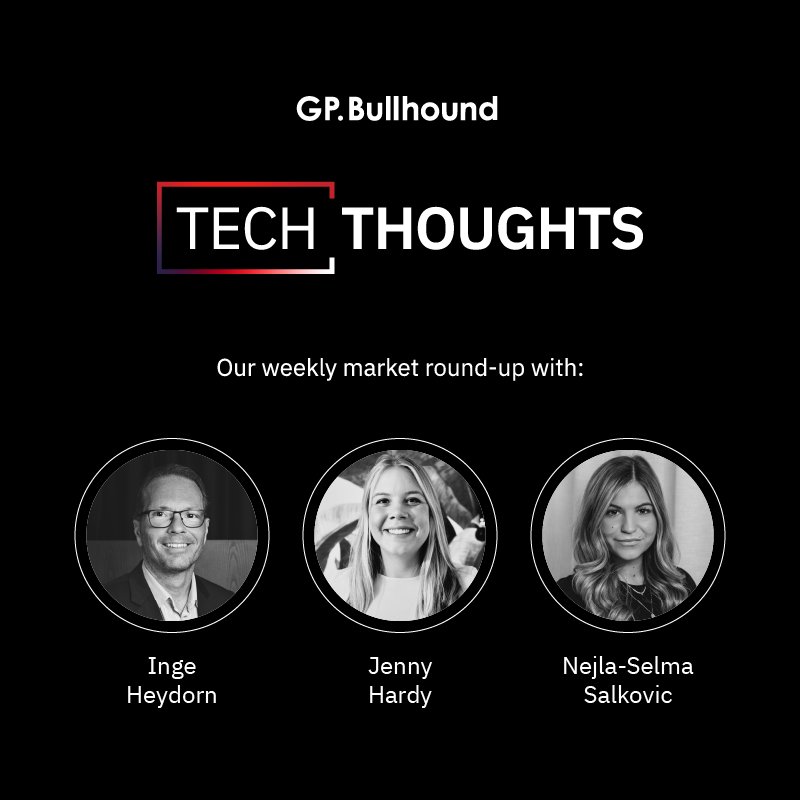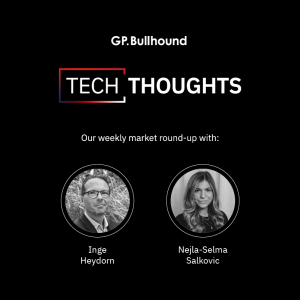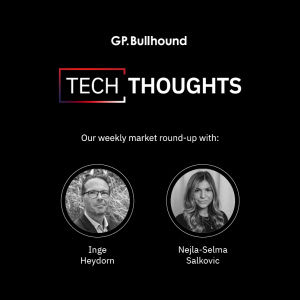Tech Thoughts Newsletter – 1 September 2023.

Market – Overall a quiet week in the market, ending what has been volatile August given higher yields and China concerns.
Portfolio: we made no major changes in the portfolio this week.
Onto results and newsflow:
Software profitability and signs of stabilisation in cloud consumption
- Salesforce (owned) reported strong results in the face of what has been quite negative sentiment.
- Revenue and cRPO were both better and Salesforce also raised FY24 guidance ahead of consensus.
- They also raised operating margin again (this is the third raise in a row) to 30% from 28%
- CEO Marc Benioff was typically bullish on the call – “we are at the dawn of an AI revolution… I think that AI is about to really ignite a buying revolution. I think we’ve already started to see that with our customers and even some of these new companies like OpenAI. And we certainly see that in our customers’ base as well.”
- While there’s clearly a heavy dose of PR around AI, there are reasons to believe Salesforce stands a good chance of being one of the enterprise software winners in AI with a suite of products(Slack/Tableau/data cloud/marketing/commerce etc) around which it can build AI features and with much more data around which to build their own models and plug ins. 6 of their top 10 wins in the quarter included 5 of more clouds.
- It’s important because it brings ARPU upside (price increases announced last quarter will start to have an impact over the next 1-3 years, and its AI features will also be priced separately) which in a pretty fully penetrated market is needed for a reacceleration of growth.
- In cloud consumption, following Snowflake’s signs of stabilisation last week, Elastic and MongoDB both reported solid results, both showing much better than expected cloud consumption and spending trends.
Portfolio view: There’s no doubt Salesforce have executed excellently this year – they’ve shifted the balance between growth and profitability (albeit with some pressure from activist shareholders) which has made sense in a more measured spending environment and it positions them well if AI does ignite a “buying revolution”.
Generally around the cloud consumption software companies we’ve been cautious around the low visibility that exists within a consumption business model, high valuation, and still uncertain path to profitability. After Snowflake last week and now Elastic and MongoDB there are increasing signs that we’re through the worst of the spend and consumption down cycle.
AI server strength, PC showing deteriorating pricing dynamics
- HPE reported solid results overall. Its compute and storage business continues to see elongated cycle times and customers digesting inventory, but there are some positives here as management noted indications of stabilisation and spoke to sequential improvement in demand.
- In the Edge and AI business the company are seeing strength – AI related orders are close to $1.6bn (the same as last quarter) and the pipeline remains strong
- Management’s commentary around availability of chips is consistent with our view that Nvidia GPUs remain supply constrained “we start now shipping some of those orders, those wins, but it’s long ways to go. And remember that there’s two components related to that. Number one is availability supply, which obviously in the AI space is constrained.”
- Broadcom (owned, small position), sales and earnings came broadly in line with expectations.
- The growth is mainly coming from connecting AI clusters of GPUs and CPUs, while the rest of the business is – as management reaffirmed, experiencing a “soft landing”
- Specifically they expect networking revenue to accelerate to above 20% yr/yr, “driven by the strength obviously in generative AI where we forecast to grow about 50% sequentially and almost two times year-on-year.”
- The demand for normal X86 CPU servers is still weak and is going through an inventory adjustment – as we’ve heard elsewhere from Intel and HPE (although Broadcom has very limited inventories – which were down again sequentially in the quarter).
- HP Inc (not owned) reported weak revenue numbers again and downgraded its full year outlook (and reduced its PC TAM expectations). Last quarter we commented on signs of ASP weakness, which this quarter was more obvious, with management commenting on an aggressive pricing environment. So while units were slightly more stable this was more than offset by ASPs on the downside.
- Dell reported a solid quarter, and raised its revenue guide for the full year.
- AI servers increased to 20% of the total server mix for H1 orders, which contributed to overall growth in ASPs, despite the legacy server weakness.
- There were early signs of demand stabilisation in their commercial PC segment within SMB
- Like we saw in HP commentary, demand for Dell’s AI server’s significantly exceeds supply, with the main constraint clearly Nvidia chips. They currently have a 39 week lead time.
Portfolio view: The AI server shift is happening, with Nvidia chips the key components, only held back by supply. Dell management commented that they’re tracking alternative accelerator chips, which isn’t a surprise –and we still believe that the currently shortages will bode well for AMD’s entry into the pure GPU market as a credible alternative to Nvidia (we own both).
The PC market still not a market we want to be exposed to – as we’ve commented before on smartphone, units can improve but the PC market is still very vulnerable to competitive pricing dynamics.
AI landscape continues to evolve
- OpenAI launched an enterprise version of ChatGPT which allows unlimited use of GPT-4, data encryption and a guarantee that enterprise data isn’t used by OpenAI. The latter addresses some of the concerns enterprises have had around data privacy and their data being used in OpenAI’s model.
- Pricing hasn’t been released but relatedly, it was also reported this week that OpenAI is on pace to generate $1 billion in revenue over the next 12 months.
- Google held its event, with AI of course the big feature.
- Google’s own in house developed AI TPU chip is the most advanced of the hyperscalers (AWS also has its Inferentia and Trainium chips), and importantly also has its own TPU architecture. It showcased its latest version (v5) at the event. It has 2x the training performance and 2.5x the inference performance per dollar vs the v4
- It also runs virtual machine instances on Nvidia GPUs and announced that it would have its latest instances available this month – good news for Nvidia supply.
Portfolio view: there’s still a lot to be determined about how AI gets used in businesses, the revenue models that will emerge, whether large enterprises will build their own proprietary models, or connect third party models (like OpenAI) to their own systems or plug ins to a separate LLM (which likely makes much more sense for small and medium businesses rather than building their own)
We’ve said before that to the extent that Google can apply AI to its core advertising business to give better conversion rates for its advertisers, it will be one of the biggest beneficiaries.
It is also by far the most advanced of the hyperscalers in its own in house chip architecture which could be a significant advantage as GPU compute continues to be in high demand with limited ability to increase capacity in the current chip shortage.
China auto strength
- BYD, the world’s largest electric vehicle manufacturer, reported strong results, and more important was management’s commentary around continued strength in demand, with August orders up 15% mth/mth, with its 2023 3m unit now looking very achievable/conservative.
- China’s NEV penetration is set to reach close to 40% by year end – the market has seen extraordinary growth helped by continued subsidies.
Portfolio view: The EV shift and the increased semiconductor requirements in EV continue to be a key exposure in the portfolio for us – we own Infineon and NXP, both of whom sell into BYD
China smartphone news – Xiaomi and Huawei
- Xiaomi reported better than expected earnings, benefitting from its focus on the premium smartphone segment. It saw sequential shipment growth which management expect to continue, with inventory digestion largely completed with channel inventory and in house inventory back to more normal levels – so continued signs of stabilisation in smartphone.
- Staying on China smartphone, Huawei’s new flagship smartphone Mate 60 sold out within the first hour. Huawei revised up their FY smartphone shipment guidance from 30m to 40m in June.
Portfolio view: signs of life in the China smartphone market indeed! Though Huawei’s release (and the Mate 60’s advanced features) did bring back into focus the ways in which China might be circumventing the US restrictions (given Huawei was added to the US entity list back in 2019). Geopolitics and China/US tensions remains a key factor to consider in semis investing.
Geopolitics back into focus in the chip market
- Nvidia this week announced in a 10Q filing that the US government had asked for additional licensing requirements for a subset of A100 and H100 chips being shipped into the Middle East. The same restrictions will apply to AMD’s advanced chips.
Portfolio view: both companies came out and said that the new licensing wouldn’t have any material impact on revenue, though this seems more likely to be about preventing China circumventing the restrictions with orders via the Middle East… as above, the threat of increased restrictions in semis continues to be a risk factor to consider.
Finally, on gaming, subscription price increases
- Sony (owned) hiked the price of its core gaming PlayStation Plus subscription service by close to a third
- It follows Microsoft’s price increases for its Game Pass service earlier this summer.
Portfolio view: price increases anywhere bode well for profitability, and it’s one of the appealing characteristics in a subscription business – the ability to raise prices on a sticky customer base.

For enquiries, please contact:
Inge Heydorn, Partner, at inge.heydorn@gpbullhound.com
Jenny Hardy, Portfolio Manager, at jenny.hardy@gpbullhound.com
Nejla-Selma Salkovic, Analyst, at nejla-selma.salkovic@gpbullhound.com
About GP Bullhound
GP Bullhound is a leading technology advisory and investment firm, providing transaction advice and capital to the world’s best entrepreneurs and founders. Founded in 1999 in London and Menlo Park, the firm today has 14 offices spanning Europe, the US and Asia.

